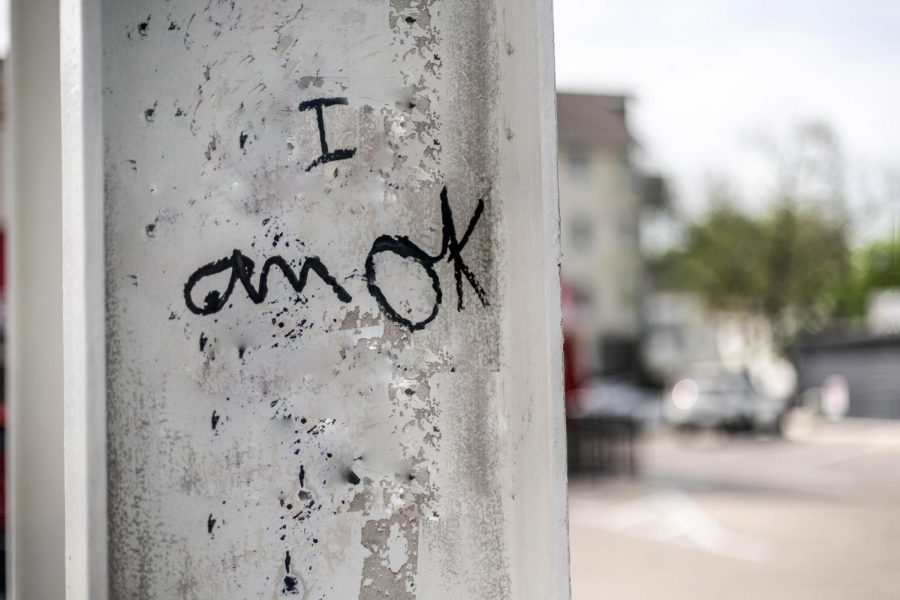Community response to widespread graffiti near campus varies
April 17, 2023
Content warning: This story mentions sexual assault.
The same message has appeared on trash cans, mailboxes, electrical boxes, the walls of apartment buildings and businesses across UT and West Campus. It reads “Even though I was raped, I am okay,” in the same distinctive cursive handwriting.
Since it started appearing at the beginning of the semester, these eight words have sparked dialogue about sexual assault throughout the UT community, since the graffiti is most prominent in this area. Some who have encountered the graffiti feel it is triggering and insensitive — sparking a cleanup project to remove the graffiti. Social media posts and Reddit threads have denounced the vandalism, saying the message serves as a constant reminder to survivors of their own sexual assault.
Other community members feel the graffiti is an anonymous survivor’s way of coping with their trauma.
“Both of those reactions are real, understandable and valid,” said Juliana Gonzales, senior director of sexual assault and health services at Stop Abuse for Everyone. “It’s very valid for someone to make expressing themselves about the sexual assault part of their healing journey. And certainly, we don’t want to silence that. … The act of expressing oneself as part of the healing process after a sexual assault can be very powerful. (But) at the same time, not everyone is in a position to interact with those expressions.”
A retriggering experience
West Campus resident Julia French had a panic attack when they first saw the graffiti in January, and was immediately taken back to the moment of their sexual assault.
“My first reaction was smelling my attacker — remembering so vividly,” French said. “I felt like I was in the room again. And it was just weird because I was just having a beautiful morning walking my dog, minding my own business, and I don’t know — it was really hard.”
In this first instance, French, who is using an alias to protect their identity, said they were able to go home and calm down, but then the message appeared on their electrical box, and then on a brick wall directly outside their front door, taking up a 6-foot-long space.
This is when French decided to take action. They put up a flier urging the artist to stop tagging the message, organized a GoFundMe to raise money for cleaning supplies to cover up the graffiti, made a shared Google Maps to track it and created a group of people who teamed up to take down the tags.
“I don’t think the police need to be involved,” French said. “I don’t want this person punished. I don’t have any hate toward them, in the end, I just hate rape. And I really want them to stop.”
The University of Texas Police Department is aware of the graffiti and is actively investigating the incident, Stephanie Jacksis, UTPD director of communications said in an email. Because of the active investigation, UTPD can not give any additional information, Jacksis said. Austin police said it has closed two cases that involved the graffiti.
It is not the message itself that is upsetting to so many survivors, French said. Instead, it is the message’s constant reminder of sexual assault and the graffiti’s immense prominence, they said, which strikes survivors as insensitive.
“I don’t hate it as a message,” French said. “I’m actually really happy for them if that’s true. But to me, there’s just no need to put it everywhere. That’s something that you should write on your personal social media, write an article about it, write a blog post about it (or) talk to your friends about it. Put it somewhere that if someone is uncomfortable, they can walk away from it.”
The Cleanup
Nearly 15 people have reached out to French to relay their own negative, triggering experience with the graffiti, which also appeared on their homes, apartments or buildings around campus.
One specifically striking email, French said, was from a survivor who saw the graffiti as they were walking home after being sexually assaulted. Stories like these inspired the cleanup movement, French said.
An initial donation of $40 from a friend kicked off the cleanup mission. However, French said the act of removing paint from surfaces is tedious and difficult, which is why they painted flowers over the graffiti outside their apartment building.
French said apartment complexes and managers have removed the graffiti from their buildings upon their own accord, and in general, the number of graffiti sightings has gone down since its peak in February, when it was nearly impossible to walk two blocks in West Campus without seeing the message.
As of now, there are eight pinned locations on French’s map.
Still, French said the cleanup effort feels never-ending and exhausting.
“I went down to Pease Park … (and) there’s one on the rocks in the river,” French said. “That’s my decompression spot. It’s annoying enough that it’s on my house, but I go to take a breather somewhere and have a relaxing day on my hammock, and then I look over, and there it is.”
French believes the tagger is one person since the handwriting is consistently the same among all of the locations. They plan to continue the cleanup effort.
“I want people to feel safe, and that means not being reminded of the worst moment of their lives,” French said.
Resources
Survivors who see the graffiti and are triggered by its message can receive aid from on-campus resources such as Not On My Campus and Voices Against Violence, which help arrange academic accommodations, connect survivors to counselors and provide safe spaces for survivors of sexual assault.
The University’s Title IX office is another avenue for student survivors who wish to pursue a grievance process or receive support and services.
Sexual assault grievances fall under Track A or Track B within the Title IX office, said Adriana Alicea-Rodriguez, University Compliance Services associate vice president and Title IX coordinator.
“The difference is that Track A are things that meet all the criteria under the federal regulations for Title IX,” Alicea-Rodruigez said. “In other words, both parties are affiliated and it happened at a University-owned property or University-sponsored event. Track B is still any incidents of sexual assault, sexual harassment, dating domestic violence and stalking, but may happen for example, off-campus or a complainant that is not affiliated to the University but the respondent is and so we would still address that.”
For Track A and B grievances, a hearing committee determines if the respondent receives sanctions. Sanctions for student respondents can range from disciplinary probation to expulsion, Alicea-Rodriguez said.
From the beginning of the 2022-2023 school year to March 31, Title IX received 110 formal complaints — but only 4% of these complaints chose to pursue the grievance process, Alicea-Rodriguez said. Thirty-nine percent of the reports are seeking support and resources, 22% of reports are connected with confidential resources on campus and 35% are either duplicate reports or non-Title IX-related matters, which are directed elsewhere.
In the 2021-2022 school year, the office received a total of 483 complaints, over 85% of those sought only support and services, according to last year’s report on the Title IX office.
Over the years, however, some survivors have felt the Title IX process does not provide adequate support and justice for survivors.
English junior Pramika Kadari, events chair for Not On My Campus, shared her own frustrations with Title IX after she went through the grievance process during her freshman year.
“It was just frustrating because, at least when I was there when I was going through it, I felt like a lot of the communication was frustrating,” Kadari said. “Whoever was deciding the outcome of my case … they were uninformed about the way that trauma can impact you and what consent means, so that made me really mad.”
At Not On My Campus, Kadari is involved with the peer educator program, which seeks to gather representatives from all campus organizations to inform them about consent and trauma-related to sexual assault. She said the initiative was initially focused on Greek Life but has expanded to include various other organizations.
‘Survivors have all kinds of reactions’
When it comes to the graffiti’s message, Kadari said she does not have a negative response.
“It seems like a survivor who’s trying to send a message in some way that probably helps them,” Kadari said. “It seems empowering to them, so it doesn’t seem upsetting to me.”
Gonzales reiterated this sentiment, emphasizing that the graffiti, at its face value, is a survivor expressing themselves.
She said her reaction to the graffiti is different from the public’s because her job is to believe survivors. Every time a survivor walks through the door of SAFE, she said it is her job to provide them services and resources as if this were the case.
“In my experience, survivors have all kinds of reactions … to their own sexual assault (and) it varies day to day,” Gonzales said. “There’s a pretty broad spectrum. It is normal for us to see survivors who are not OK after a sexual assault. And it is also normal to see survivors who are OK. And that doesn’t mean that the sexual assault was OK, or that it should have happened, or that it’s OK to do that to someone.”
If you’re seeking short-term crisis support, SAFE’s hotline 512-267-7233 is available 24/7, as well as their text line, 737-888-7233. SAFE also provides counseling for survivors in Austin. April is also sexual assault awareness month, and Voices Against Violence is hosting events throughout the month, including trauma-informed yoga and wellness labs.





